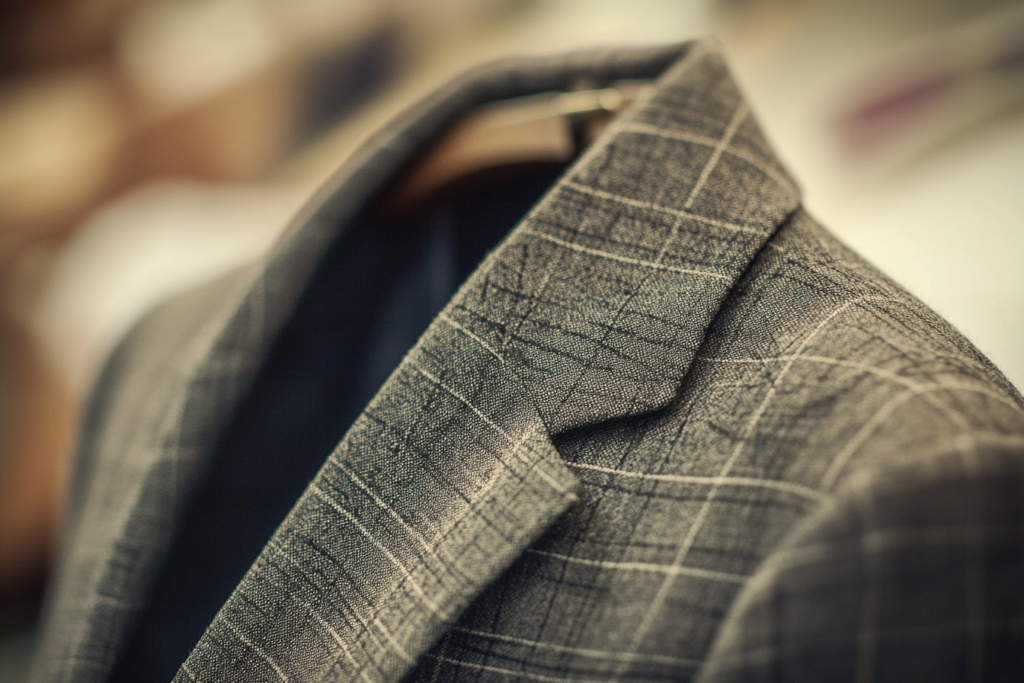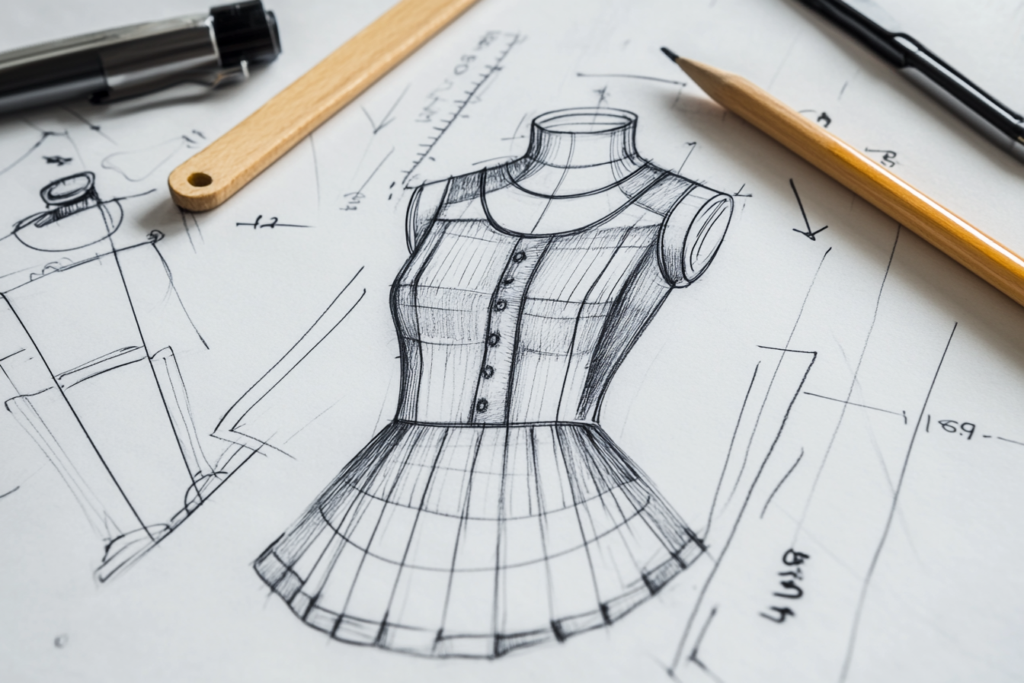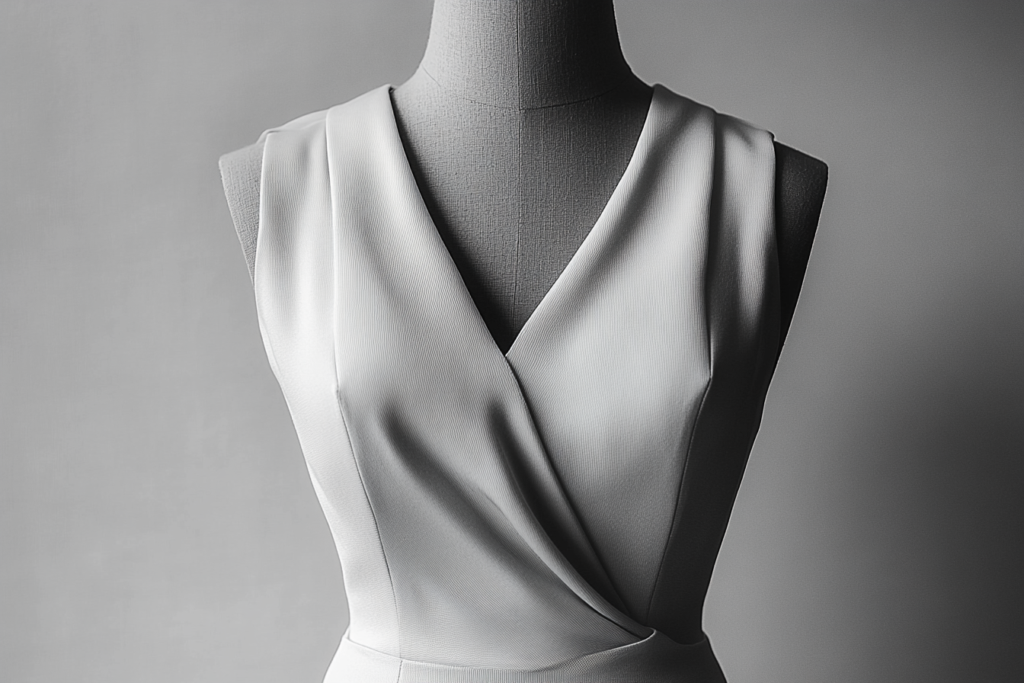Introduction: What is a Dart?
A dart is a shaping technique used in garment construction to remove excess fabric and ensure a better fit around curves. Typically used in the waist, bust, and hip areas, darts help garments conform to the natural shape of the body. Whether in a blouse, dress, or tailored jacket, darts create a smooth, flattering silhouette by making sure the fabric molds seamlessly to the wearer’s shape.
The process of adding a dart involves folding fabric in a particular way and stitching it along the fold, which gathers and reshapes the fabric. Darts are not only functional but also an important aesthetic element in garment design, allowing for a more polished, tailored look.


How Darts Work in Garment Construction
- Identifying the Excess Fabric:
- The first step in creating a dart is identifying the areas where there is excess fabric. Typically, darts are used around the bust, waist, or back, where the fabric needs to be gathered in to create a more flattering, fitted shape.
- Marking the Dart:
- Once the fabric is laid out, the dart’s position is marked on the pattern or directly on the fabric. The markings indicate where the fabric should be folded and sewn together. Depending on the design, darts can be placed at various points to ensure the garment fits smoothly over the body’s curves.
- Folding and Stitching:
- The fabric is folded along the marked lines, and the dart is stitched. The sewing is done from the wide end of the dart, gradually tapering to the narrow point. The stitches are generally made with a fine thread to ensure a neat, discreet finish.
- Pressing the Dart:
- After the dart is sewn, it is important to press it properly. Darts are typically pressed towards the center or downwards, depending on the garment’s design. This ensures that the fabric lies flat and the shape remains smooth.
Types of Darts
- Single-Point Dart:
- A single-point dart is the most common type of dart and is used to shape areas like the bust or waist. It starts at one point and tapers down to a narrow end, allowing for a smooth fit over a curved area.
- Double-Point Dart (Princess Dart):
- A double-point dart, also known as a princess dart, is used to shape more complex curves, such as in the bust and hip areas. It has two points, which can create more defined shaping along the body. This dart is often seen in dresses or jackets that require more structure.
- French Dart:
- A French dart is a longer, slanted dart that starts from the side seam and angles toward the bust or waist. This type of dart is typically seen in tailored garments like fitted blouses or dresses, offering a more elegant and elongated shape.
- Seam Dart:
- A seam dart is integrated into a seam of the garment, such as in the side or back seams. This dart helps provide shaping while maintaining the flow of the overall design.
Why Darts Are Essential in Garment Design
- Shaping and Fit:
- Darts are an essential part of tailoring, helping garments conform to the body’s natural curves. Without darts, garments would lack the structure and shape that give them a polished, well-fitted appearance.
- Enhancing Comfort:
- Properly placed darts can also enhance the comfort of a garment. By removing excess fabric in the right areas, darts ensure that the garment moves with the body and doesn’t pinch or sag in unwanted places.
- Improved Aesthetics:
- Darts contribute to the overall aesthetics of a garment by creating clean lines and a tailored silhouette. They are an important design element in achieving a sophisticated, professional look, especially in women’s clothing.
- Versatility in Design:
- Darts can be used in a wide variety of garments, from casual wear to formal wear, and can be adapted to different fabrics and styles. They provide designers with the flexibility to achieve the desired fit and look, whether it’s a relaxed shape or a more structured silhouette.
Common Garments that Use Darts
- Blouses and Shirts:
- Darts are commonly used in blouses and shirts to add shape to the bust or waist. This helps create a more fitted, feminine look, especially in tailored or button-up shirts.
- Dresses:
- Many dresses, especially those with a fitted bodice or waist, rely on darts for shaping. Darts help to contour the dress to the body, allowing for a flattering silhouette.
- Jackets and Coats:
- Darts are also used in tailored jackets and coats to add structure to the garment. This helps achieve a sharp, professional look and allows the garment to follow the natural lines of the body.
- Skirts and Pants:
- In skirts and pants, darts can be used to shape the garment around the waist and hips, ensuring a smooth and flattering fit. This is especially useful for high-waisted or pencil skirts.
How to Sew a Dart
- Mark the Dart on the Fabric:
- Start by marking the dart on the fabric with a fabric marker or chalk. Ensure that the dart is symmetrical and aligned properly with the garment’s design lines.
- Pin the Fabric:
- Pin the fabric along the dart lines, aligning the edges as evenly as possible to ensure a straight seam.
- Sew the Dart:
- Begin sewing at the wide end of the dart and gradually taper towards the narrow point. Be careful to sew in a straight line to create a smooth, even dart. Backstitch at the beginning and end to secure the dart in place.
- Press the Dart:
- After sewing the dart, press it flat. Darts are usually pressed towards the center of the garment (for bust darts) or downward (for waist darts). This helps smooth the fabric and enhances the shape.
Conclusion: The Role of Darts in Garment Construction
Darts are an essential tool in creating well-fitted garments. Whether used for shaping the bust, waist, or hips, they help remove excess fabric and contour the garment to the body’s natural lines. By providing a more tailored and flattering silhouette, darts enhance both the comfort and aesthetic of a garment. Whether in casual, formal, or tailored pieces, darts remain a crucial technique in fashion design and garment construction.



